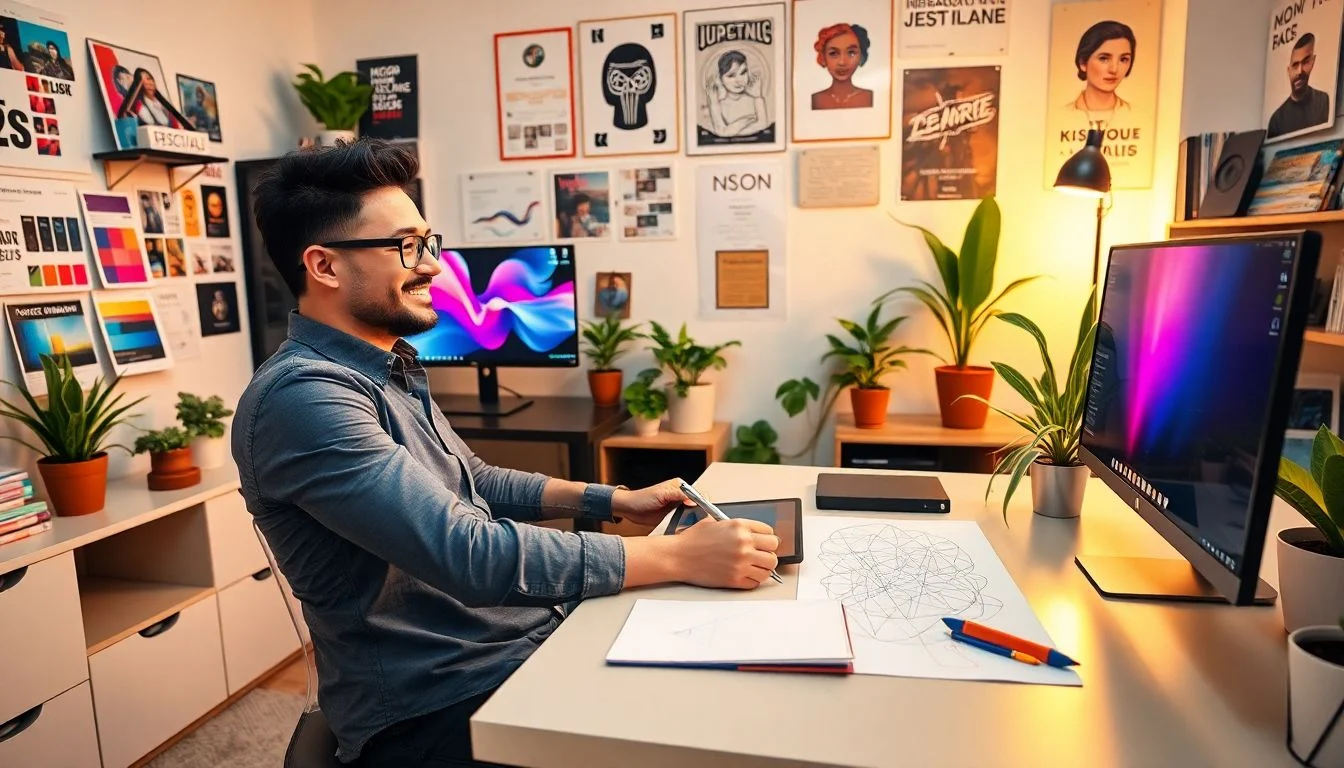The demand for talented graphic designers is booming. Companies are shifting more towards branding, marketing, and online presence. This means lots of opportunities for those who know how to craft eye-catching visuals. But standing out isn’t easy. Success blends creativity, tech skills, and a smart approach to business. Whether you’re just starting or looking to level up, this guide offers steps to grow your skills, build a great portfolio, and connect with the right people.
1. Building a Strong Foundation in Graphic Design
1.1 Understanding the Fundamentals of Design
Before you dive into complex projects, learn the core ideas behind good design. Think about color—how different shades affect mood. Learn about typography—how fonts tell stories. Focus on layout—arranging elements so they’re easy to read. And study visual hierarchy—guiding viewers’ eyes to what matters most. Mastering these basics is key. It makes advanced work more natural and your designs more professional.
1.2 Educational Pathways and Certifications
You don’t need a super fancy degree, but formal education helps. Many colleges offer degrees in graphic design or art. Online courses also provide flexible options. Platforms like Coursera, Skillshare, and LinkedIn Learning teach everything from beginner to advanced skills. Certifications can boost your credibility, too. Getting certified as an Adobe Expert shows clients you’re serious and skilled.
1.3 Essential Design Software Skills
Knowing industry tools is a must. Adobe Photoshop, Illustrator, and InDesign are standard. Photoshop handles editing photos, Illustrator is perfect for logos, and InDesign makes layouts for magazines or flyers. Plus, emerging tools like Figma for UI design, Canva for quick projects, and Procreate for illustrations are worth exploring. Keep learning new updates and features so your skills stay fresh.
2. Developing a Unique Style and Building a Portfolio
2.1 Cultivating Your Creative Voice
What makes your work stand out? It’s your style. Try different techniques and styles—minimalist, bold, vintage, modern. Look at other designers you admire. Notice what grabs your eye and why. As you experiment, develop a look that is uniquely yours. Consistency matters—you want clients and fans to recognize your work instantly.
2.2 Crafting a Standout Portfolio
Show off your best work. Be sure to include diverse projects—logos, posters, social media graphics, and more. Explain your process in case studies; clients love to see how you solve problems. Remember, a well-organized website with easy navigation or a physical portfolio book makes a big impression. Add personal projects or fun ideas to highlight your creativity.
2.3 Leveraging Personal Projects and Collaborations
Create passion projects that excite you. Maybe redesign a local charity’s logo or craft posters for a band. Collaborate with friends, non-profits, or startups. Real-world experience sharpens your skills. Always ask permission before sharing client work, and respect confidentiality rules.
3. Gaining Experience and Credibility in the Industry
3.1 Internships and Entry-Level Positions
Look for internships or junior roles to get hands-on work. These work experience opportunities help you learn industry standards. Plus, they give you a foot in the door. Apply widely and be persistent—every project makes you better.
3.2 Freelancing and Client Work
Websites like Upwork, Fiverr, and 99designs connect you with clients looking for designers. Start small, build trust, and grow your reputation. Set fair rates—undercharging can hurt your business. Always use a clear contract to protect both sides, and communicate openly.
3.3 Participating in Design Contests and Competitions
Contests are a fantastic way to challenge yourself. They also get your name out there. Platforms like 99designs or DesignCrowd host these competitions often. Winning isn’t everything—it’s about learning, improving, and getting noticed.
4. Mastering Business Skills and Networking
4.1 Personal Branding and Online Presence
Your website and social media are your storefront. Create a professional portfolio online. Share your process or “behind-the-scenes” looks to engage followers. Consistency shows your passion and skills.
4.2 Networking and Industry Engagement
Attend design events, workshops, and local meetups—anywhere you can meet others. Join professional groups like AIGA or the Graphic Artists Guild. Building connections can lead to jobs and collaborations.
4.3 Marketing and Self-Promotion Strategies
Word of mouth is powerful. Ask satisfied clients for referrals. Write blogs or tutorials to showcase your skills. Partner with marketing firms or small businesses. The more you put yourself out there, the more work comes your way.
5. Staying Inspired and Evolving as a Designer
5.1 Continuing Education and Skill Expansion
Design is always changing. Keep up with trends, new software, and emerging tech like motion graphics or UI/UX work. The more skills you gain, the more versatile you become.
5.2 Seeking Feedback and Mentorship
Don’t be afraid to ask for critiques. Join groups where designers give honest reviews. Finding a mentor can accelerate your growth and provide real-world advice.
5.3 Setting Professional Goals
Define where you want to go—should you work for a big agency, or want to freelance full-time? Make short-term goals, like learning a new skill, and long-term plans, like opening your own studio. Track your progress and celebrate every milestone.
6. Final Words
Becoming a successful graphic designer takes more than just making pretty images. It’s about building a strong foundation, developing a voice, and staying active in the industry. Keep learning, build a top-notch portfolio, and make genuine connections. Passion and perseverance are your best tools. Always stay curious, adapt, and grow with the profession. Take action today—your dream design career awaits.


 Continue With
Google
Continue With
Google
Comments (0)